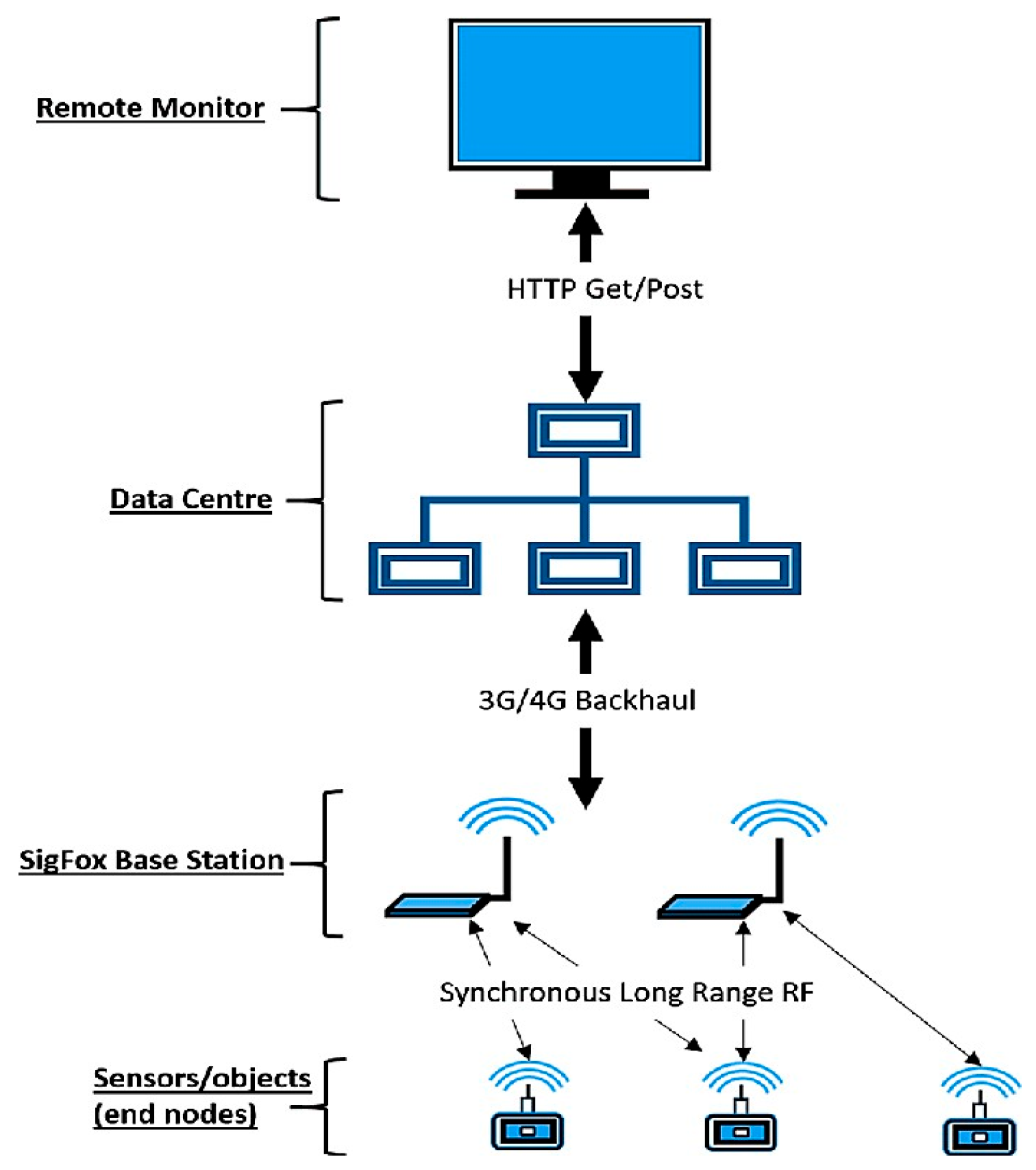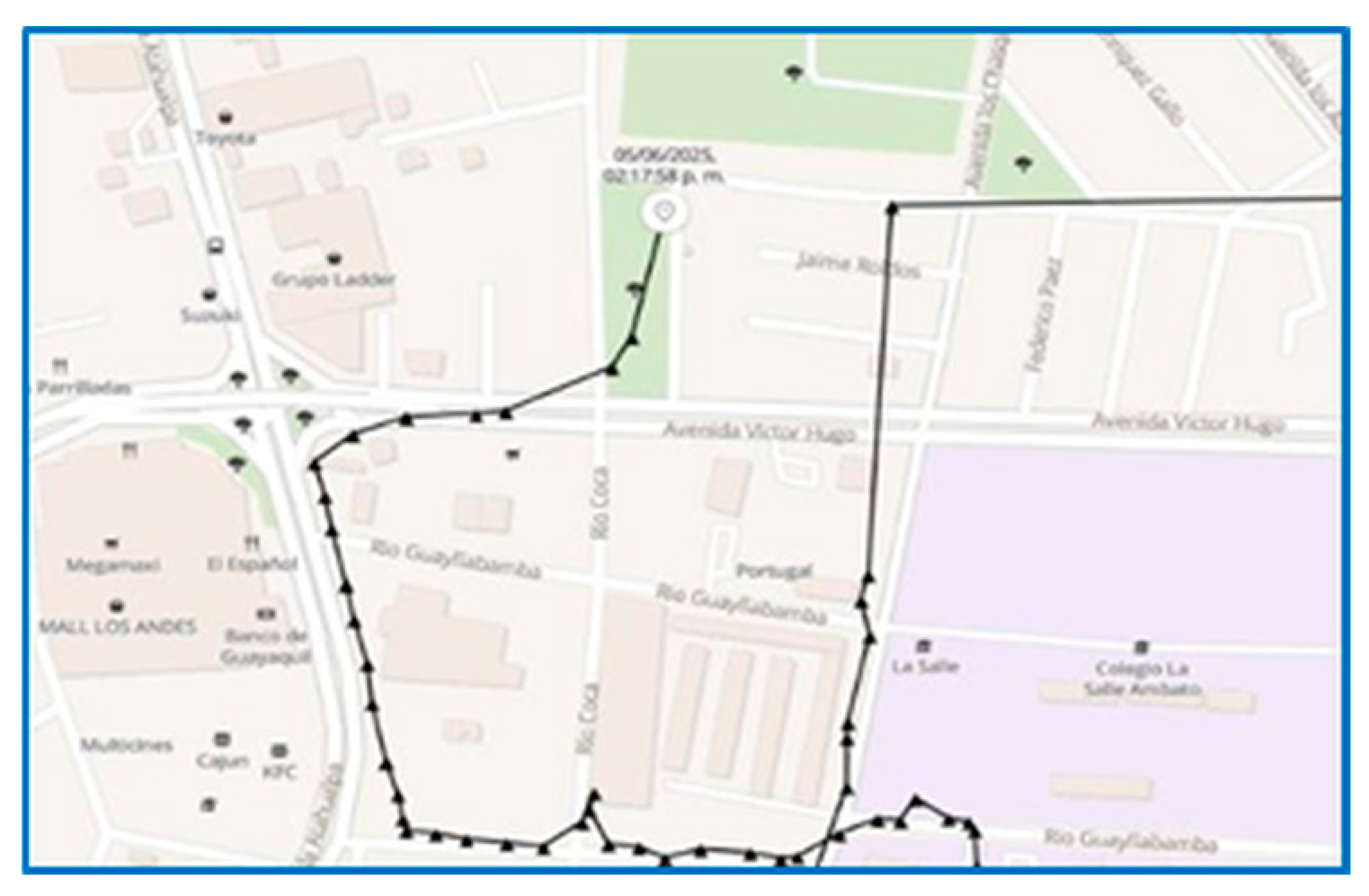IoT-Based Geolocation System Using Sigfox Network for Enhanced Student Safety: Design, Implementation, and Real-World Performance Evaluation †
Abstract
1. Introduction
2. Related Works
3. Materials and Methods
3.1. Evaluation of Sigfox-Compatible Visualization Platforms
- Accuracy: Measured by comparing recorded GPS coordinates with an actual route followed by a student within educational institutions. A platform was considered accurate if it faithfully represented the trajectory, including turns, intersections, and path segments. Result: Traccar demonstrated high accuracy with well-aligned points. ThingsBoard Cloud showed greater dispersion in some sections, likely due to signal loss or visualization delays.
- Latency: Time elapsed between data transmission from the device and its visualization on the platform. Stopwatch-based tests determined average delays in seconds. Result: Traccar achieved lower latency, with near real-time updates. ThingsBoard Cloud had longer response times, especially in low-coverage areas.
- Interoperability: Assessed by ease of integration with IoT devices, external APIs, and visualization tools, using a test environment with multiple sensors and web services. Result: Both platforms offered good integration capabilities, with ThingsBoard Cloud excelling in node- and rule-based architectures for complex data flows.
- Usability: Evaluated via interface design, configuration ease, and learning curve for users with basic technical skills, using structured questionnaires. Result: Traccar was rated as more intuitive for real-time tracking, while ThingsBoard Cloud provided greater customization at the cost of longer setup times.
3.2. Traccar Plataform
3.3. Development of a GPS NEO-6M and Ufox Transmitter Prototype
4. Results
4.1. Test—Juan León Mera La Salle Educational Unit
4.2. Test—Ricardo Descalzi Educational Unit
5. Discussion
6. Conclusions
Author Contributions
Funding
Institutional Review Board Statement
Informed Consent Statement
Data Availability Statement
Acknowledgments
Conflicts of Interest
References
- Instituto Nacional de Estadística y Censos. Tecnología. I. N. de Estadística y Censos. Tecnología de la Información y Comunicación-TICs. July 2024. Available online: https://www.ecuadorencifras.gob.ec/tecnologias-de-la-informacion-y-comunicacion-tic/ (accessed on 3 October 2025).
- ARCOTEL. Informe de Gestión Año 2023; Agencia de Regulación y Control de las Telecomunicaciones: Quito, Ecuador, 2024. [Google Scholar]
- Ministerio de Educación. MINEDUC-MINEDUC-2023-00069-A; Ministerio de Educación del Ecuador: Quito, Ecuador, 2023. [Google Scholar]
- Cando Toapanta, E.F. Sistema de Comunicación IoT Para el Rastreo y Localización de Niños con Tecnología Sigfox Para la Ciudad de Ambato, Ecuador; Universidad Técnica de Ambato: Ambato, Ecuador, 2024. [Google Scholar]
- Guachamin, J.J.A.; Almeida, T.F.S. Implementación de un Prototipo Para Localización de Personas de la Tercera Edad Utilizando una Aplicación Móvil con Sistema Operativo Android y Tecnología Sigfox. Master’s Thesis, Escuela Politécnica Nacional, Quito, Ecuador, 2024. [Google Scholar]
- Rojas Mora, P.A. Sistema de Geolocalización Mediante Tecnología IoT Para el Monitoreo de Personas; Universidad Nacional de Loja: Loja, Ecuador, 2024. [Google Scholar]
- Rivera, C.; Héctor, J. Reducción de Error de Geolocalización de la Red Sigfox Asistido Por GPS. Master’s Thesis, Instituto Tecnológico Superior de Teziutlán, Merida, Mexico, 2020. [Google Scholar]
- Vivek, K.; Swetha, G.; Veni, A.K.; Praveen, N.; Kale, M.R. Role of IoT in Smart Cities: A Review, Applications, Open Challenges and Solutions. In Proceedings of the 2025 International Conference on Electronics and Renewable Systems (ICEARS), Tuticorin, India, 11–13 February 2025; pp. 596–601. [Google Scholar] [CrossRef]
- Flores, L.A.; Lomas, I.; Guachalá, L.; Lupera-Morillo, P.; Álvarez, R.; Llugsi, R. Direction-of-Arrival (DOA) Estimation Based on Real Field Measurements and Modified Linear Regression. Eng. Proc. 2024, 77, 11. [Google Scholar] [CrossRef]
- Bi, Z.; Wang, G.; Xu, L.D. A visualization platform for internet of things in manufacturing applications. Internet Res. 2016, 26, 377–401. [Google Scholar] [CrossRef]
- Sosa, E.O.; Sosa, M.E. Potenciando el Desarrollo de IoT con Tecnología LPWAN: Caso de Estudio en la Universidad Nacional de Misiones. Rev. Cienc. Tecnol. 2023, 40, 7. [Google Scholar] [CrossRef]
- Purnama, A.A.F.; Nashiruddin, M.I. SigFox-based Internet of Things Network Planning for Advanced Metering Infrastructure Services in Urban Scenario. In Proceedings of the 2020 IEEE International Conference on Industry 4.0, Artificial Intelligence, and Communications Technology (IAICT), Bali, Indonesia, 7–8 July 2020. [Google Scholar] [CrossRef]
- Rahman, M.A. Development Children 4.0 concept for information security of school-age children based on wearable technology. Probl. Inf. Soc. 2024, 15, 71–82. [Google Scholar] [CrossRef]
- Flor Bonifaz, P.E.; Rojas Calupiña, R.A. Desarrollo de un Prototipo Electrónico Para el Monitoreo de Niños Dentro de un Área Establecida en Espacios Públicos. Master’s Thesis, Universidad Politécnica Salesiana, Quito, Ecuador, 2017. [Google Scholar]
- López, M. IoT-based student tracking system for smart campuses using MQTT and GPS modules, module. IEEE Internet Things J. 2022, 9, 677–685. [Google Scholar]
- Lavric, A.; Popa, V. Internet of Things and LoRa™ Low-Power Wide-Area Networks: A Survey. In Proceedings of the 2017 International Symposium on Signals, Circuits and Systems (ISSCS), Iasi, Romania, 13–14 July 2017; pp. 1–5. [Google Scholar] [CrossRef]
- Flores, A.; Alvarez, R.; Lupera, P.; Tipantuña, C.; Llugsi, R.; Lara, F. Real-Time Speed Measurement of Moving Objects with Continuous Wave Doppler Radar Using Software-Defined Radio: Implementation and Performance Analysis. Electronics 2025, 14, 4225. [Google Scholar] [CrossRef]
- Acosta, C.E.; Vizcaino, E.R. Mapa de cobertura de la red Sigfox en Ecuador (Sigfox, 2022). (Este es un mapa de cobertura específico para Ecuador). ResearchGate. 2022. Available online: https://www.researchgate.net/figure/Figura-1-Mapa-de-cobertura-de-la-red-Sigfox-en-Ecuador-Sigfox-2022_fig1_365306188 (accessed on 10 June 2025).





| Platform | Accuracy | Latency | Interoperability | Usability |
|---|---|---|---|---|
| Traccar | 3 | 2 | 3 | 2 |
| ThingsBoard Cloud | 2 | 1 | 1 | 2 |
| Datacake | 2 | 1 | 1 | 1 |
| Timestamp | Temperature (°C) | Latency (s) | Battery (mV) | Accuracy (%) |
|---|---|---|---|---|
| 14:07:10 | 25.1 | 30 | 356 | 0 |
| 14:08:41 | 28.7 | 91 | 355 | 100 |
| 14:09:11 | 29.5 | 30 | 356 | 100 |
| 14:09:41 | 28.6 | 30 | 353 | 0 |
| 14:10:11 | 26.7 | 30 | 354 | 100 |
| 14:10:41 | 26.4 | 30 | 356 | 100 |
| 14:11:11 | 28.2 | 30 | 353 | 100 |
| 14:11:41 | 28.7 | 30 | 353 | 100 |
| 14:12:11 | 30.8 | 30 | 355 | 100 |
| 14:12:41 | 29.4 | 30 | 356 | 100 |
| 14:13:11 | 30.2 | 30 | 353 | 0 |
| 14:14:12 | 30.0 | 61 | 354 | 100 |
| 14:14:43 | 30.6 | 31 | 355 | 100 |
| 14:15:13 | 27.5 | 30 | 353 | 100 |
| 14:15:44 | 25.8 | 31 | 355 | 100 |
| 14:16:15 | 25.2 | 31 | 354 | 100 |
| 14:16:43 | 28.5 | 28 | 355 | 100 |
| 14:17:14 | 28.2 | 31 | 354 | 100 |
| 14:17:43 | 29.8 | 29 | 353 | 100 |
| 14:18:13 | 30.4 | 30 | 353 | 100 |
| 14:18:43 | 28.1 | 30 | 353 | 0 |
| 14:19:15 | 25.8 | 32 | 356 | 100 |
| 14:19:43 | 28.2 | 28 | 353 | 100 |
| 14:20:13 | 30.1 | 30 | 354 | 0 |
| 14:20:43 | 28.5 | 30 | 354 | 100 |
| 14:22:12 | 28.2 | 89 | 353 | 100 |
| 14:23:09 | 31.0 | 57 | 354 | 100 |
| 14:24:22 | 30.3 | 73 | 354 | 100 |
| 14:25:38 | 27.1 | 76 | 354 | 100 |
| 14:26:28 | 30.6 | 50 | 353 | 100 |
| 14:27:53 | 28.7 | 85 | 353 | 100 |
| 14:28:29 | 30.1 | 36 | 354 | 0 |
| 14:29:29 | 29.6 | 60 | 355 | 100 |
| 14:30:33 | 27.1 | 64 | 353 | 100 |
| 14:31:18 | 30.7 | 45 | 353 | 0 |
| 14:32:34 | 25.7 | 76 | 354 | 0 |
| Average | 28.6 | 43.2 | 354.06 | 78 |
| Timestamp | Temperature (°C) | Latency (s) | Battery (mV) | Accuracy (%) |
|---|---|---|---|---|
| 08:35:15 | 24.8 | 15 | 353 | 0 |
| 08:35:30 | 25.4 | 25 | 354 | 100 |
| 08:35:55 | 26.0 | 15 | 355 | 100 |
| 08:36:10 | 26.6 | 25 | 353 | 100 |
| 08:36:35 | 27.2 | 15 | 354 | 0 |
| 08:36:50 | 24.8 | 25 | 355 | 100 |
| 08:37:15 | 25.4 | 15 | 353 | 0 |
| 08:37:30 | 26.0 | 25 | 354 | 0 |
| 08:37:55 | 26.6 | 15 | 355 | 0 |
| 08:38:10 | 27.2 | 25 | 353 | 0 |
| 08:38:35 | 24.8 | 15 | 354 | 100 |
| 08:38:50 | 25.4 | 25 | 355 | 0 |
| 08:39:15 | 26.0 | 15 | 353 | 0 |
| 08:39:30 | 26.6 | 25 | 354 | 100 |
| 08:39:55 | 27.2 | 15 | 355 | 100 |
| 08:40:10 | 24.8 | 25 | 353 | 100 |
| 08:40:35 | 25.4 | 15 | 354 | 100 |
| 08:40:50 | 26.0 | 25 | 355 | 0 |
| 08:41:15 | 26.6 | 15 | 353 | 0 |
| 08:41:30 | 27.2 | 25 | 354 | 0 |
| 08:41:55 | 24.8 | 15 | 355 | 100 |
| 08:42:10 | 25.4 | 25 | 353 | 0 |
| 08:42:35 | 26.0 | 15 | 354 | 0 |
| 08:42:50 | 26.6 | 25 | 355 | 100 |
| 08:43:15 | 27.2 | 15 | 353 | 100 |
| 08:43:30 | 24.8 | 25 | 354 | 100 |
| 08:43:55 | 25.4 | 15 | 355 | 100 |
| 08:44:10 | 26.0 | 25 | 353 | 100 |
| 08:44:35 | 26.6 | 15 | 354 | 100 |
| 08:44:50 | 27.2 | 25 | 355 | 100 |
| 08:45:15 | 24.8 | 15 | 353 | 0 |
| 08:45:30 | 25.4 | 25 | 354 | 100 |
| 08:45:55 | 26.0 | 15 | 355 | 0 |
| Average | 25.9 | 19.8 | 354 | 55 |
Disclaimer/Publisher’s Note: The statements, opinions and data contained in all publications are solely those of the individual author(s) and contributor(s) and not of MDPI and/or the editor(s). MDPI and/or the editor(s) disclaim responsibility for any injury to people or property resulting from any ideas, methods, instructions or products referred to in the content. |
© 2025 by the authors. Licensee MDPI, Basel, Switzerland. This article is an open access article distributed under the terms and conditions of the Creative Commons Attribution (CC BY) license (https://creativecommons.org/licenses/by/4.0/).
Share and Cite
Robalino Peña, E.F.; Maldonado, J.; Flores, L.A.; Freire, L.O.; Trujillo, F.; Castillo, J. IoT-Based Geolocation System Using Sigfox Network for Enhanced Student Safety: Design, Implementation, and Real-World Performance Evaluation. Eng. Proc. 2025, 115, 24. https://doi.org/10.3390/engproc2025115024
Robalino Peña EF, Maldonado J, Flores LA, Freire LO, Trujillo F, Castillo J. IoT-Based Geolocation System Using Sigfox Network for Enhanced Student Safety: Design, Implementation, and Real-World Performance Evaluation. Engineering Proceedings. 2025; 115(1):24. https://doi.org/10.3390/engproc2025115024
Chicago/Turabian StyleRobalino Peña, Edgar Freddy, Jhon Maldonado, Luis Antonio Flores, Luigi O. Freire, Fabricio Trujillo, and Jessica Castillo. 2025. "IoT-Based Geolocation System Using Sigfox Network for Enhanced Student Safety: Design, Implementation, and Real-World Performance Evaluation" Engineering Proceedings 115, no. 1: 24. https://doi.org/10.3390/engproc2025115024
APA StyleRobalino Peña, E. F., Maldonado, J., Flores, L. A., Freire, L. O., Trujillo, F., & Castillo, J. (2025). IoT-Based Geolocation System Using Sigfox Network for Enhanced Student Safety: Design, Implementation, and Real-World Performance Evaluation. Engineering Proceedings, 115(1), 24. https://doi.org/10.3390/engproc2025115024






